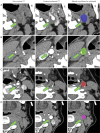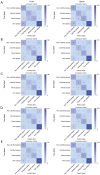Classification of carotid artery plaques: promising alternative methods to computed tomography angiography through radiomics approach using neck non-contrast computed tomography
- PMID: 40384670
- PMCID: PMC12082581
- DOI: 10.21037/qims-24-1974
Classification of carotid artery plaques: promising alternative methods to computed tomography angiography through radiomics approach using neck non-contrast computed tomography
Abstract
Background: Carotid artery plaques (CAPs) significantly contribute to stroke. Accurate plaque characterization is crucial for predicting stroke risk. This study explored the effectiveness of a non-contrast computed tomography (NCCT)-based radiomics model in identifying and classifying CAPs.
Methods: The dataset included 600 patients with CAPs from two centers, who were divided into training (n=400), internal test (n=100), and external test sets (n=100). Radiomics features were extracted from NCCT images. Five algorithms-Gaussian processes (GP), support vector machine (SVM), decision tree (DT), logistic regression (LR), and random forest (RF)-were employed to develop a two-level binary classification model (TBCM) and four-class classification model (FCM) for predicting the four CAP subtypes. TBCM comprised three binary classifiers. Receiver operating characteristic (ROC) curve analysis was used to evaluate model performance.
Results: In FCM, 38 optimal features were selected. For TBCM, 14, 13, and 22 optimal features were selected from classifiers 1-3, respectively. The GP [with areas under the ROC curves (AUCs) of 0.892-1 for three classifiers] and RF models (with AUCs of 0.883-1 for three classifiers) exhibited superior performance in the internal test set. The model combining GP and RF yielded AUCs of 0.893-1. In the external test set, the GP model achieved AUCs of 0.902-1 for three classifiers, compared with 0.939-1 for the RF model. The combined model achieved AUCs of 0.939-1 for three classifiers.
Conclusions: This study highlights the efficacy of the NCCT-based radiomics model in discerning the composition of CAPs.
Keywords: Carotid artery plaques (CAPs); model construction; non-contrast computed tomography scan (NCCT scan); radiomics.
Copyright © 2025 AME Publishing Company. All rights reserved.
Conflict of interest statement
Conflicts of Interest: All authors have completed the ICMJE uniform disclosure form (available at https://qims.amegroups.com/article/view/10.21037/qims-24-1974/coif). E.X. and A.L. are employees of Shanghai United Imaging Intelligence Co., Ltd. The other authors have no conflicts of interest to declare.
Figures






Similar articles
-
Computed tomography angiography-based radiomics model for predicting carotid atherosclerotic plaque vulnerability.Front Neurol. 2023 Jun 16;14:1151326. doi: 10.3389/fneur.2023.1151326. eCollection 2023. Front Neurol. 2023. PMID: 37396779 Free PMC article.
-
Association of Pathological Features and Multiparametric MRI-Based Radiomics With TP53-Mutated Prostate Cancer.J Magn Reson Imaging. 2024 Sep;60(3):1134-1145. doi: 10.1002/jmri.29186. Epub 2023 Dec 28. J Magn Reson Imaging. 2024. PMID: 38153859
-
Non-Contrasted CT Radiomics for SAH Prognosis Prediction.Bioengineering (Basel). 2023 Aug 16;10(8):967. doi: 10.3390/bioengineering10080967. Bioengineering (Basel). 2023. PMID: 37627852 Free PMC article.
-
Computed tomography-based radiomics machine learning classifiers to differentiate type I and type II epithelial ovarian cancers.Eur Radiol. 2023 Jul;33(7):5193-5204. doi: 10.1007/s00330-022-09318-w. Epub 2022 Dec 14. Eur Radiol. 2023. PMID: 36515713
-
A retrospective study differentiating nontuberculous mycobacterial pulmonary disease from pulmonary tuberculosis on computed tomography using radiomics and machine learning algorithms.Ann Med. 2024 Dec;56(1):2401613. doi: 10.1080/07853890.2024.2401613. Epub 2024 Sep 16. Ann Med. 2024. PMID: 39283049 Free PMC article.
References
LinkOut - more resources
Full Text Sources
Miscellaneous
